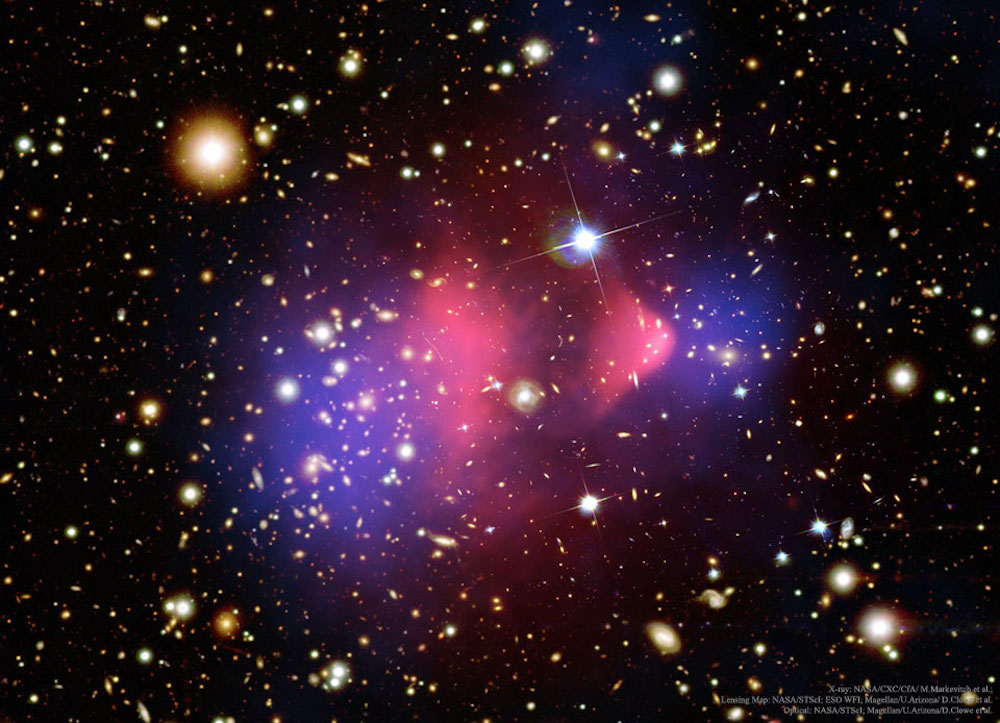Create a free profile to get unlimited access to exclusive videos, sweepstakes, and more!
So this is what really happens during the most epic galactic crashes
What did merging galaxies go through through between the first and last phase? Now we know, and it's gnarly.

Because the universe must have thought a collision between galaxies just wasn’t entertaining enough, clusters of hundreds to thousands of galaxies also merge, but how?
Part of that question was hanging in space for years, but finally has an answer. Astronomers have known that merging galaxy clusters take one shape when they start out and eventually morph into another at the end of the merger. However, something was missing — what they went through in between those phases was unknown until now. It was thought that there had to be a sharp cone shape between the blunt body in the beginning and the extended shape near the end. That has been proven right.
After observing galaxy cluster ZwCl 2341+0000 (that name is a cluster in itself) through the Chandra X-ray Space Telescope for an exhausting 55 hours, a team of astronomers, including Aurora Simionescu from the SRON/Leiden Observatory in the Netherlands was able to capture the elusive middle phase of the merger. The cone shape appears and vanishes so fast it can easily be missed. Simionescu coauthored a study, soon to be published in Astronomy & Astrophysics, about the transformation.
“When two clusters of galaxies crash into each other, the gas of the ‘cone’ feels the push from the gas of the other cluster it collided with,” she told SYFY WIRE. "The pressure from this other gas is different at different parts of the surface of the original ‘blunt body’, so over time it changes its shape into a cone.”
Orbs are floating around everywhere in the universe. If you really think about it, so many types of objects, from stars to planets to galaxy clusters, are spheres. When one such galaxy cluster and another are pulled towards each other by their immense gravity, they manage to hang on to the sphererical shape for as long as they possibly can. This is the blunt body phase. Imagine you are standing on the beach, watching the waves make their journey to the shore. The blunt body is most similar to waves that are just starting to form and are more like rounded ripples than anything resembling a peak. That’s next.
Somewhere in between a wave starting out and growing to its full size before it collapses on the shore, it takes on a triangular sort of shape that is not just a ripple, but not yet that majestic crest you often see surfers riding. A star surfer would have to first get through the middle phase before that grand finale. The blunt body is pushed by gas until it rises to a triangular peak that is so fleeting, it is possibly the reason for it not being discovered for so long: it transforms again too soon to be identified. It is soon after that when the cone shape rises into the crested shape that probably comes to mind when you think of a wave. It is seen as more of a tongue-like shape when it occurs in galaxies.
“What happens in the wave is that the water at the top of the wave is falling back towards the ocean surface, what happens in the ‘tongue’-like clusters is that some gas at the tip of the infalling subcluster is falling back down towards the center of mass between the two merging systems,” Simionescu said.
Stars and galaxies don’t usually smash each other in galaxy cluster collisions. What really collides is the intergalactic medium (ICM) of both clusters, while the galaxies themselves pass each other as if nothing was happening. The ICM is superhot gas that can only be observed by X-ray telescope because of its extreme heat. Though its particles are spaced far apart, particles mean it still has mass. It also takes up much more space in the cluster than its galaxies do. The shapes that gradually change over millions of years, like the blunt bodies shown in blue and pink in the merging Bullet Cluster above, are the ICM.
Galaxy clusters like the Bullet Cluster could actually let us in on dark matter. Because a glob of merging galaxies has so much mass, and therefore immense gravity, it warps whatever is behind it. The stars behind the Bullet cluster appear warped and magnified because of this phenomenon, known as gravitational lensing. How much distortion is going on could tell us the total mass of a cluster. Take away all the visible matter, and what you’re left with is probably dark matter that is otherwise unobservable.
“Most of the Bullet Cluster’s total mass was in a different place than most of the ‘normal’ mass, which can be traced by the X-ray gas, when it was observed,” said Simionescu. “Therefore, most of the total mass causing the gravitational lensing must be dark matter.”
Morphing galaxies revealing more about dark matter? As an intergalactic surfer would say, gnarly.


























